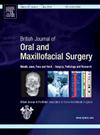The goat as a model for temporomandibular joint disc replacement: Techniques for scaffold fixation
IF 1.7
4区 医学
Q3 DENTISTRY, ORAL SURGERY & MEDICINE
British Journal of Oral & Maxillofacial Surgery
Pub Date : 2025-02-01
DOI:10.1016/j.bjoms.2024.10.233
引用次数: 0
Abstract
A state-of-the-art scaffold capable of efficiently reconstructing the temporomandibular joint (TMJ) disc after discectomy remains elusive. The major challenge has been to identify a degradable scaffold that remodels into TMJ disc-like tissue, and prevents increased joint pathology, among other significant complications. Tissue engineering research provides a foundation for promising approaches towards the creation of successful implants/scaffolds that aim to restore the disc. In light of improving the quality of life of patients who undergo TMJ disc removal, it is critical to establish a preclinical animal model to evaluate the properties of promising scaffolds implanted post-discectomy and to determine the most efficient implantation procedures to ensure a more reliable in-depth evaluation of the biomaterial replacing the articular disc. The present study evaluated the outcomes of two protocols for implantation of an acellular scaffold composed of an extracellular matrix (ECM) derived from the small intestinal submucosa (SIS) of the pig, as a regenerative template for the TMJ disc in a goat model. The outcomes suggest that leaving one-half of the disc medially will allow anchoring of the device to the medial aspect of the joint while avoiding lateral displacement of the ECM scaffold. The goat model is ideal to assess the longevity of tissue-engineered solutions for the TMJ disc, considering that goats chew for 12–16 hours a day. This study provides an important reference for the selection of a suitable scaffold implantation procedure and the goat model for the development of new strategies to assess TMJ disc regeneration.
山羊作为颞下颌关节盘置换术模型:支架固定技术。
一种能够在椎间盘切除术后有效重建颞下颌关节(TMJ)椎间盘的最先进的支架仍然难以捉摸。主要的挑战是确定一种可降解的支架,它可以改造成TMJ椎间盘样组织,并防止关节病理的增加,以及其他显著的并发症。组织工程研究为成功地创造旨在恢复椎间盘的植入物/支架提供了有前途的方法基础。为了提高颞下颌关节椎间盘摘除术患者的生活质量,建立临床前动物模型来评估椎间盘摘除术后植入支架的性能,确定最有效的植入方法,以确保更可靠地深入评估替代关节盘的生物材料是至关重要的。本研究评估了两种方案的植入结果,该方案由来自猪小肠粘膜下层(SIS)的细胞外基质(ECM)组成的脱细胞支架作为山羊模型TMJ椎间盘的再生模板。结果表明,将椎间盘的一半置于中间将允许将装置锚定在关节的内侧,同时避免ECM支架的外侧移位。考虑到山羊每天咀嚼12-16个小时,山羊模型是评估TMJ椎间盘组织工程解决方案寿命的理想选择。本研究为选择合适的支架植入方式和山羊模型提供了重要参考,为制定评估TMJ椎间盘再生的新策略提供了参考。
本文章由计算机程序翻译,如有差异,请以英文原文为准。
求助全文
约1分钟内获得全文
求助全文
来源期刊
CiteScore
3.60
自引率
16.70%
发文量
256
审稿时长
6 months
期刊介绍:
Journal of the British Association of Oral and Maxillofacial Surgeons:
• Leading articles on all aspects of surgery in the oro-facial and head and neck region
• One of the largest circulations of any international journal in this field
• Dedicated to enhancing surgical expertise.

 求助内容:
求助内容: 应助结果提醒方式:
应助结果提醒方式:


